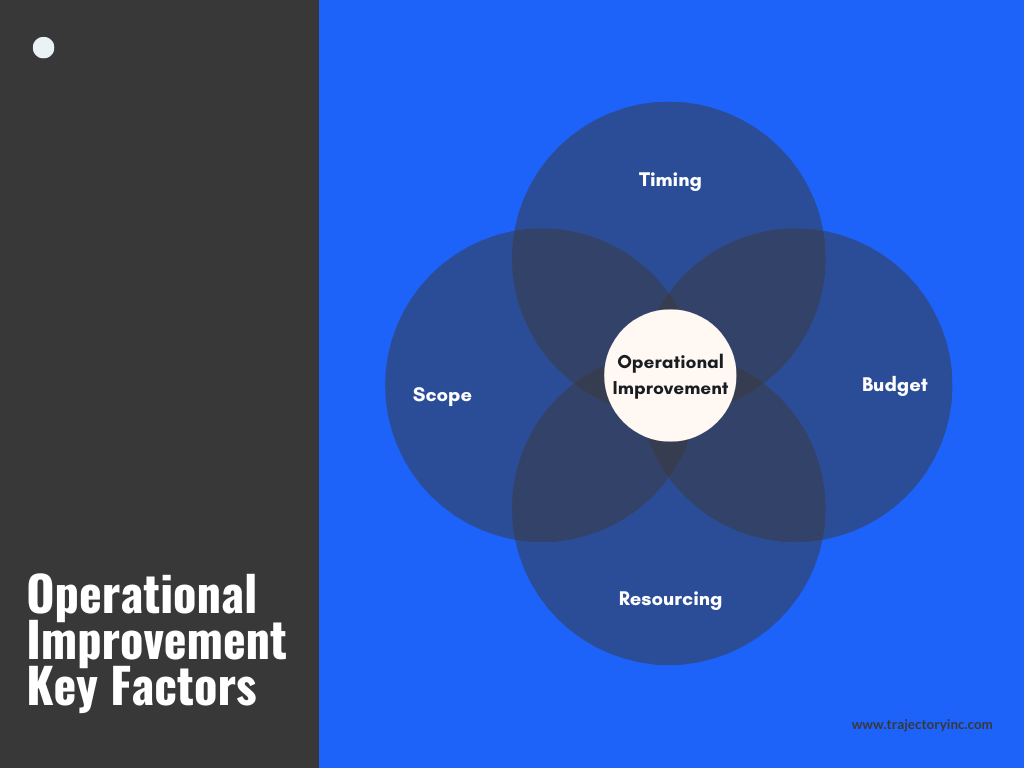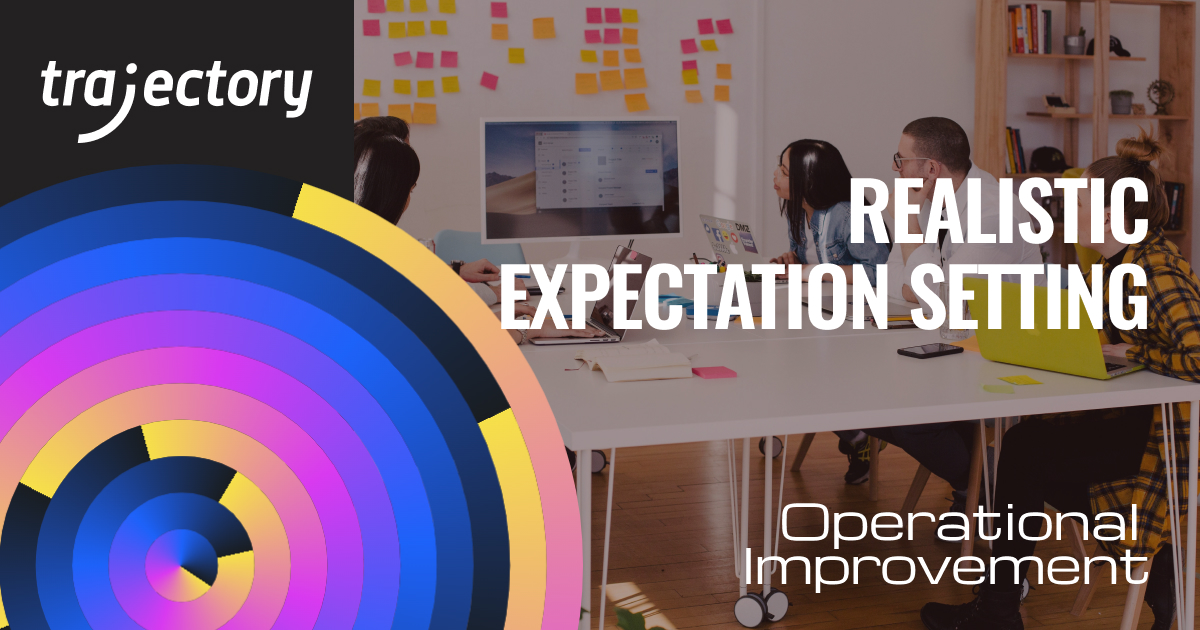“Blessed is he who expects nothing, for he shall never be disappointed.”
― Alexander Pope, 18th Century Poet
Unfortunately, this centuries-old adage doesn’t hold water in the context of operational improvement. To attain operational excellence, you have to not only set expectations, which is arguably the easy part, but you must set realistic expectations which oftentimes can be challenging.
Much has been written about operational improvement and how to do it well, but the often-overlooked critical success factor is realistic expectation setting on behalf of all affected stakeholders, C-Suite to frontline team members. Having realistic expectations means all key stakeholders agree on the desired outcome of an operational improvement initiative, what success looks like, and how success will be measured. A lack of realistic expectation setting is often cited as a leading cause of failure. This begs the question; how does an organization accomplish realistic expectation setting? Let’s begin by exploring the parameters of realistic expectation setting and ten tips for appropriately setting those parameters.
Expectation Setting Parameters
To effectively set expectations, it is important to understand the critical parameters and how to leverage them to achieve realistic expectations. Four main parameters include: timing, budget, resourcing and scope. These parameters are inter-related and changes to one often impact the others. However, when properly defined in concert, successful operational improvement can be achieved. Let’s define these four parameters and how they can be well-managed.
1. Timing – The ability to appropriately schedule an initiative. Involves ensuring the duration of tasks are properly planned and appropriately assigned within the business cycle so they are achievable. For example, it’s not a good idea to schedule a major initiative in the middle of an organization’s busy season or over a holiday period. If timing is not thoroughly considered, it can lead to demoralization of the project team and can negatively impact their ability to complete the initiative.
2. Budget – Budgeting can be tricky, particularly when it comes to technology transformation initiatives that may not have been done before. If the initiative is something familiar to the business, consider the “costs” of execution, both the hard costs of the team’s time, solution costs, and soft costs in terms of the use of common company resources. In instances where a third-party technology solution is required, seek the advice of a trusted implementation partner to help properly scope the project and include costs of the technology solution licensing and sandbox costs. Once you’ve established a budget, add a 10% buffer, to account for changes along the way. Perception of the project will be more positive if it remains at or near budget. Inaccurate budgeting can put not only a damper on the initiative, it can also affect the willingness to pursue future initiatives.
3. Resourcing – Ensuring the right project stakeholders (i.e. Subject Matter Experts, day-to-day operations, management) are involved from the start. Engaging stakeholders from the jump helps develop communal buy-in for the initiative. Determining the right project team is the first step. – also ensure the team members have the appropriate skill-sets, attitudes and time to complete the initiative. Perhaps adjust the levers of timing to schedule the initiative for a slower period, extend timelines to make it less stressful, or bring in other resources to take some of the day-to-day work over from the project team. The initiative won’t be successful without a motivated team to make it happen, so setting appropriate resourcing expectations is key.
4. Scope – Define exactly what is going to be accomplished. Generally, the bigger the scope, the more resources needed, the higher the cost and the longer the timeline. You can control this parameter by defining what are the critical outcomes of the operational initiative and defining the minimum requirements to achieve success. Having a clear sense of desired project outcomes and goals can help you make decisions, about which elements to address as part of the core initiative and what to shelve for future consideration. Having consensus about appropriate project scope at the outset of an initiative is helpful for fostering operational improvement success.
Finessing the parameters above appropriately with realistic values, and gaining buy-in for the proposed initiative, you establish a strong foundation for operational improvement. But how do you determine what the parameters should be for a particular initiative?

10 Tips for Establishing Realistic Expectations
Let’s dig into tips for accurately determining the parameter values:
- Define Future State Vision and Initiative Goals – Setting desired end state and initiative goals up front will help guide decisions throughout. This vision act like a North Star, guiding project-related actions to ensure you attain your goals. This requires Executive-level communication with input from all impacted stakeholders, ensuring the goals align with the needs of the organization.
- Establish Definition of ‘Success’ – Senior management must also define what success looks like, and establish the KPIs that will be tracked to assess success or failure. The definition of success may vary between stakeholders, so aligning on what this looks like is critical for success.
- Understand Your Business Processes – It’s easy to get carried away by the excitement of embarking on a new initiative, and to jump right into execution. But, taking the time to map out existing business processes and define desired future state (that aligns with activity 1 above) with stakeholders buy-in will go a long way to smoothing out the implementation and adoption.
- Document Detailed Business Requirements – When getting ready to implement something new, be sure to sit down with all stakeholders and document detailed business requirements, including what the new process should look like, what you need it to do, when you want specific things to happen, and who will be responsible for each part of the process. Clearly articulating these requirements up front will help ensure you are able to effectively manage scope, budget and timeline.
- Understand and Address Resistance – The ease of achieving operational improvement largely depends on the level of resistance to change in an organization, which can be passive or overt. Completing a change readiness assessment via surveys or focus groups can provide helpful insights to mitigate the resistance and for crafting effective change management communication. Openly acknowledging and actively managing resistance will help with user adoption levels – critical to success.
- Understand Your Constraints – Remember to be realistic about constraints in terms of people, timing, scope and budget. Consider stakeholders, their skill sets, what you expect them to achieve, how much time they have (given their other responsibilities) and how much it should cost. Setting realistic expectations around these important factors requires having a solid understanding of your team’s experience, when the busy times are in the business cycle, the details of the business processes, and how much needs to be achieved. In the case of technology implementation, an experienced partner can provide input on the scope and budget pieces based on discovering your business requirements and implementation goals.
- Evaluate Options – Determining the best approach for executing an operational improvement initiative may require surveying different solutions to support the new processes. In this case, research several options and with business requirements and existing processes in hand, request demonstrations from different providers. Particularly for critical business functionality, request customized demonstrations to ensure solutions will meet the business requirements. Even if all requirements can’t be met, you can decide which ones are deal breakers.
- Partner with an Established Vendor (when applicable) – In circumstances where technology implementation is required, join forces with an experienced shop. One who has not only specific implementation experience in your industry but operational improvement experience (being more business focused than technology-focused). One who will take the time to understand your business before suggesting the optimal technology infrastructure to meet your short and long-term goals. Also, ensure the partner you select has a solid implementation methodology you can leverage in navigating the implementation process. Added bonus: they will help you define a realistic scope and budget for the project.
- Engage all Relevant Stakeholders – Including all stakeholders in discussions during the planning phases is great for establishing a collaborative team environment and assists with assigning ownership. Full team input from the get-go also increases the chance of an acceptable if not exceptional outcome for all parties upon initiative completion.
- Be Humble – Embarking on an operational improvement initiative with an open mind and seeking input from experienced partners greatly increases the chances of success. It’s ok not to know everything, especially if you’ve never done it before. Failure is often borne by not leaning on others who have.
Conclusion
Operational improvement can be a daunting endeavor, but realistic expectation setting is a cornerstone of success. Doing your homework on business process mapping; team and business cycle analysis; and getting input from stakeholders and experienced vendors as needed, all assist with solid scope, timing, budget, and resourcing. As the time-tested adage goes, “Start as you mean to go on.”

Alex Olano
CEO, Managing Partner
Throughout his 18-year career at Trajectory, Alex’s role has ranged from managing teams and projects to running the professional services organization, and mentoring Trajectory’s growing number of Consultants. Currently, he leads the Trajectory Team and invests his time ensuring Private Equity avoids key technology risks during their transactions. Alex understands technology is simply the means for achieving business goals. He has guided Trajectory’s organization to form its own version of Operational Improvement, which combines industry and business acumen with highly effective technology implementation capabilities. Prior to joining Trajectory Group, Alex spent 10 years in business consulting, systems advisory, and SAP implementations with IBM Global Services and Accenture.




